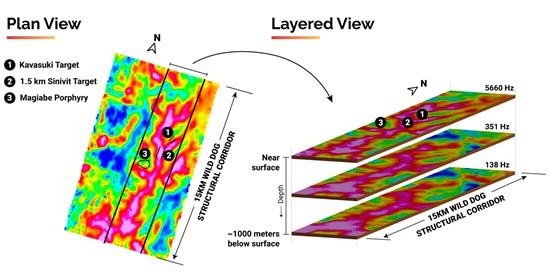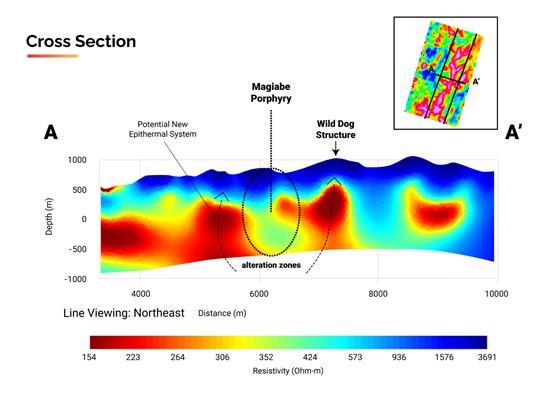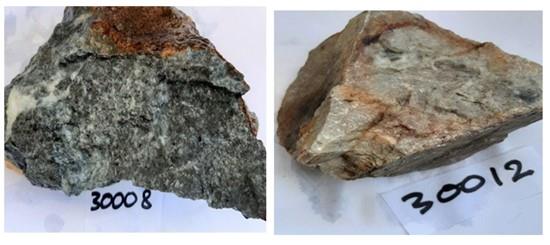
Large Scale Epithermal System And Porphyry Potential Highlighted By Mobilemt Survey At Great Pacific Gold's Wild Dog Project
| Figure 1: Apparent conductivity (5660 Hz) highlighting 15km strike length of epithermal system containing Sinivit and Kavasuki. Section A - A' for use in Figure 3 below. | Figure 2: Apparent Conductivity slices through the 15km strike length of epithermal system with highest frequency slice representing near surface and lowest frequency slice representing approximately 1,000 meters in depth. |
To view an enhanced version of this graphic, please visit:
Magiabe Porphyry Target
The Wild Dog Project area is located along PNG's circum-Pacific "Rim of Fire" arc, an environment known for world-class porphyry Cu-Au and epithermal gold deposits. At Magiabe, field mapping has identified a multiphase quartz diorite-monzonite porphyry intrusion exposed in the Magiabe Creek valley. This intrusion exhibits strong potassic alteration (e.g. secondary K-feldspar, magnetite) and is associated with an intensely phyllic-altered pebble breccia (approximately 250 m in diameter) at surface. Importantly, the Magiabe porphyry intrusive is interpreted to be coeval with the epithermal mineralization in the adjacent Nengmutka/Wild Dog vein system, suggesting a genetic link.
Historic explorers recognized Magiabe as a probable porphyry centre: the presence of mapped intrusives, breccia, porphyry-style alteration, a copper soil anomaly, and coincident geophysical signatures (magnetic high and IP chargeability) led to the interpretation that Magiabe could be the source of the Wild Dog epithermal veins. Supporting this, the Wild Dog veins themselves contain anomalous molybdenum and tellurium (elements often associated with porphyry systems) and a gold-copper association, which reinforced the Magiabe porphyry model in earlier studies. Despite these encouraging signs, the Magiabe porphyry target remained untested by drilling.
The processed MobileMT data have illuminated a compelling porphyry signature at Magiabe. In particular, a large resistivity and magnetic anomaly consistent with a potassic-altered intrusive body is centred at Magiabe. This feature, interpreted as the potassic core of a porphyry system, measures roughly 1,000 meters in diameter and extends to at least 2,000 meters depth in the 3D inversion models. Such scale is comparable to major porphyry deposits; for example, the Wafi-Golpu system's porphyry centre (Golpu) is on the order of 1-2 km across and over 1 km vertical extent. The MobileMT shows the Magiabe anomaly adjacent to and beneath the Sinivit epithermal zone, closely resembling the classic geometry of an epithermal deposit above or alongside a porphyry intrusion. The Magiabe target appears as a deep, robust conductivity/resistivity anomaly and gives GPAC a high-priority porphyry drill target.
Figure 3: Resistivity cross section highlighting the Magiabe porphyry system, along with the Wild Dog epithermal system. A further epithermal target may be present to the west of Magiabe.
To view an enhanced version of this graphic, please visit:
A 3D IP (Induced Polarization) survey in 2010 identified a circular chargeability anomaly ~200 m in diameter at Magiabe, coincident with a zone of advanced argillic clay alteration at surface. This IP anomaly broadened with depth and was detectable down to ~300 m (the limit of that survey). At surface, the Magiabe area showed a cap of pyrophyllite-dickite-kaolinite alteration (a lithocap) with fine crystalline gold panned in streams and outcrops of dacitic breccia nearby. The IP and mapping data together led geologists at the time to propose a diatreme-related Cu-Au porphyry target at Magiabe, directly drawing parallels to the lithocap above the Wafi porphyry system. Although at least one 300 m exploration hole was recommended to test this chargeability high, the drilling was never undertaken.
The MobileMT survey of 2025 has essentially "unmasked" the deeper parts of this anomaly, revealing the full vertical extent and lateral size of the Magiabe system well beyond the 2010 IP limits. The new data confirms that Magiabe is a sizeable geophysical target consistent with a porphyry intrusive centre, greatly strengthening the exploration rationale.
Field work by historic operators provided geochemical "ground truth" that supports geophysical interpretation of Magiabe as a porphyry Cu-Au system.
Figure 4: Photo of samples taken from the Magiabe porphyry float at Magiabe Creek in February 2020. Sample 30008 is a quartz diorite intrusive with fine-grained copper sulphides and sericite/chlorite alteration. The sample graded 0.12 g/t Au, 0.25%Cu, 5.6 g/t Ag and 208 ppm Mo. Sample 30012 was collected from a nearby location and is also a float sample showing silicified rock with fine-grained polymictic fluidized, sorted and silted clasts of quartz diorite and vein materials. This sample graded 2.5 g/t Au, 124 ppm Cu, 9.1 g/t Ag and 24 ppm Mo.
To view an enhanced version of this graphic, please visit:
In addition to historic work, Great Pacific Gold collected rock float and outcrop samples from the Magiabe area earlier this year (February 2025), and the assays returned strong porphyry pathfinder element signatures.
Great Pacific Gold has accordingly elevated Magiabe in its exploration plans and work is now underway to advance Magiabe towards drill-readiness. This involves detailed mapping, additional geochemical sampling, and possibly ground geophysics over the Magiabe area in the coming months. The goal is to refine drill targets within the broad anomaly.
By 2026, Great Pacific Gold anticipates initiating the first drill testing of the Magiabe porphyry system. PNG is known for giant examples (Ok Tedi, Frieda River, Wafi-Golpu, etc.). Magiabe shares many hallmarks with these systems, a strong geophysical footprint, the right geochemical "footprints" at surface, and spatial association with a productive epithermal gold field.
About the Mobile MT Survey
An airborne electromagnetic (EM) and magnetic survey was conducted by Expert Geophysics Pty Ltd. for Great Pacific Gold Corp. The objective was to collect and analyze geophysical data over the Wild Dog Project, located in the Baining Mountains, East New Britain, Papua New Guinea. Using the advanced MobileMT helicopter-borne system, the project aimed to map bedrock structure, identify lithological changes, and detect potential zones of geological alteration and mineralization. The report explains the survey's rationale, scope, and structure, highlighting the integrated approach that combines electromagnetic, magnetic, and VLF (very low frequency) data.
The Wild Dog Project survey covered an area of 191 square kilometers approximately 30 km southwest of Kokopo. A total of 1,536 line-kilometers were flown using an AS 350 B3E helicopter, deploying both an EM receiver and a magnetometer in towed 'birds' below the aircraft. The survey lines were oriented NW-SE at 100 to 200-meter intervals, with tie lines running perpendicular at 2,000-meter spacing. Average flight altitudes were carefully managed to optimize data quality, with the EM bird maintained at about 173 meters above ground. Detailed coordinates and flight path layouts ensured comprehensive and systematic area coverage.
Operations were based in Kokopo and spanned from March 20 to April 15, 2025, encompassing 20 production flights. The project included equipment mobilization, on-site assembly, system testing, daily acquisition, and demobilization phases.
State-of-the-art equipment underpinned the survey. The core MobileMT system measures natural electromagnetic fields using three orthogonal induction coils, complemented by a precision cesium magnetometer for magnetic data. A GPS-based navigation system and radar altimeter ensured precise positioning. On the ground, a stationary base station recorded reference electric fields, enhancing the accuracy and interpretability of the airborne measurements. The suite also included a digital data acquisition and processing workstation, enabling real-time quality checks and preliminary data processing in the field.
After acquisition, data were rigorously processed using proprietary methods. Electromagnetic data from the airborne and base sensors were synchronized and transformed using advanced algorithms to produce conductivity and resistivity models at various depths and frequencies. Magnetic data underwent corrections for natural field variations and leveling to eliminate noise and bias, then were gridded for visualization. VLF data from global transmitters were filtered and imaged to identify conductive zones. Final data products include digital databases, grids, maps, cross-sections, depth slices, and 3D models, all delivered in standard industry formats for seamless integration with other exploration datasets.
The survey products provide a detailed, multi-dimensional geophysical understanding of the Wild Dog area. The deliverables consist of synchronized EM, magnetic, and VLF databases, with associated maps and 3D visualizations for advanced interpretation. This robust data suite supports the identification of potential mineralization targets and informs further exploration decisions. The integrated analysis is designed to maximize exploration efficiency and de-risk subsequent drilling, positioning the project for informed decision-making and value creation.
Further Details about the July 2025 Private Placement
Further to the Company's news release dated July 3, 2025, the Company confirms that the Agents received a total cash commission of $1,016,690.40 and a total of 2,259,312 broker warrants (the "Broker Warrants") in relation to the Offering that was completed on July 3, 2025. Each Broker Warrants entitles the holder to acquire one common share at an exercise price of $0.45 per share until July 3, 2027.
On behalf of Great Pacific Gold,
Greg McCunn, Chief Executive Officer and Director

Legal Disclaimer:
MENAFN provides the
information “as is” without warranty of any kind. We do not accept
any responsibility or liability for the accuracy, content, images,
videos, licenses, completeness, legality, or reliability of the information
contained in this article. If you have any complaints or copyright
issues related to this article, kindly contact the provider above.




















Comments
No comment